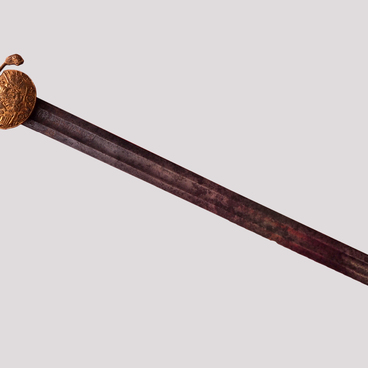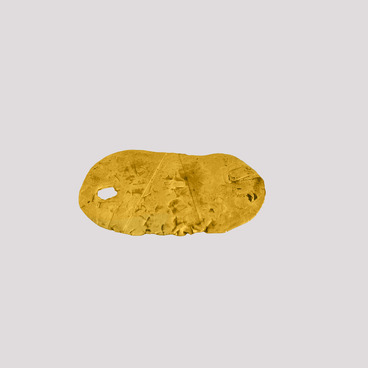The Smolensk region has a special geographic location, therefore, in local portraits, one can see a peculiar combination of all-Russian and Eastern European traditions. Among such works is a portrait of Gideon Vishnevsky, bishop of Smolensk and Dorogobuzh. The work was created by a provincial artist who lived and worked in Smolensk. Vishnevsky’s portrait is a vivid example of Smolensk painting of the second half of the 18th — early 19th centuries. A violation of proportions is felt in it, volumes are built using chiaroscuro, color plays secondary role. The figure is flat — a doubtless connection with icon-painting techniques. Gideon Vishnevsky is depicted in a dark cassock, over which a mantle is draped, bishop’s cowl on his head. In his left hand, the bishop holds a pastoral staff, and his right hand is shown in a blessing gesture.
Blazons are an interesting and rare part of the depiction of clergy. The presence of the blazon seems to be a kind of artificial step, in imitation of Polish portraits, which were probably always before the eyes of Smolensk artists. In the Ukraine and Poland, similar portraits were also created, but there they were most often placed in the interiors of churches and had extensive epitaphs in the lower part.
Gedeon Vishnevsky was born in 1678 in Ukraine into a noble family. He studied at the Kiev Theological Academy up to a philosophical class, then went abroad and studied in Vilna, Kovna and Lvov, where he received a Philosophiae Doctor from the Jesuits. Returning to his homeland, he became a teacher of rhetoric and poetry at the Kiev Academy. In 1712 he taught rhetoric in a private house. Two years later, Vishnevsky became a teacher of philosophy at the Moscow Theological Academy, and in 1723 was appointed rector of the Moscow Academy and archimandrite of the Zaikonospassky monastery. According to the recollections of contemporaries, Gedeon Vishnevsky was distinguished by energy, justice and tenacity in protecting the interests of the clergy, although he was very strict and exacting to both the clergy and the flock. He punished with whips for drunkenness.
On June 19, 1728, Vishnevsky became Bishop of Smolensk and Dorogobuzh. In Smolensk, he opened a theological seminary. He died on February 2, 1761 and was buried in the Smolensk Assumption Cathedral.
Blazons are an interesting and rare part of the depiction of clergy. The presence of the blazon seems to be a kind of artificial step, in imitation of Polish portraits, which were probably always before the eyes of Smolensk artists. In the Ukraine and Poland, similar portraits were also created, but there they were most often placed in the interiors of churches and had extensive epitaphs in the lower part.
Gedeon Vishnevsky was born in 1678 in Ukraine into a noble family. He studied at the Kiev Theological Academy up to a philosophical class, then went abroad and studied in Vilna, Kovna and Lvov, where he received a Philosophiae Doctor from the Jesuits. Returning to his homeland, he became a teacher of rhetoric and poetry at the Kiev Academy. In 1712 he taught rhetoric in a private house. Two years later, Vishnevsky became a teacher of philosophy at the Moscow Theological Academy, and in 1723 was appointed rector of the Moscow Academy and archimandrite of the Zaikonospassky monastery. According to the recollections of contemporaries, Gedeon Vishnevsky was distinguished by energy, justice and tenacity in protecting the interests of the clergy, although he was very strict and exacting to both the clergy and the flock. He punished with whips for drunkenness.
On June 19, 1728, Vishnevsky became Bishop of Smolensk and Dorogobuzh. In Smolensk, he opened a theological seminary. He died on February 2, 1761 and was buried in the Smolensk Assumption Cathedral.

